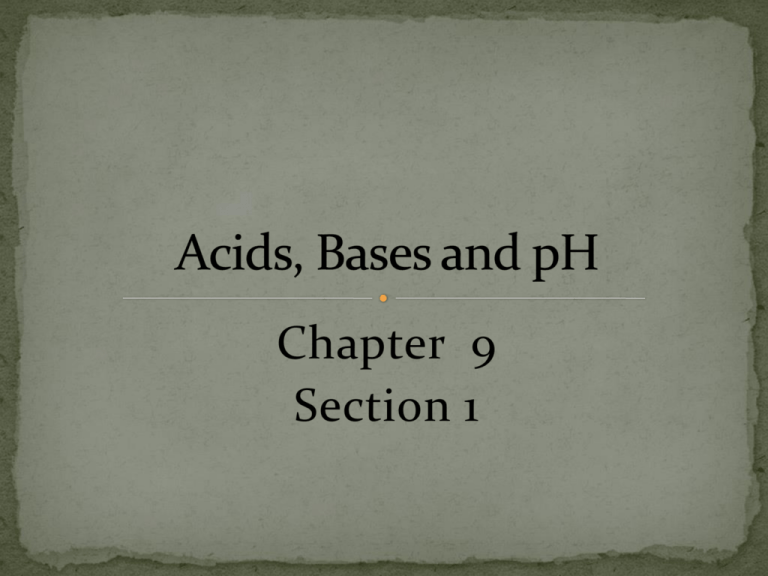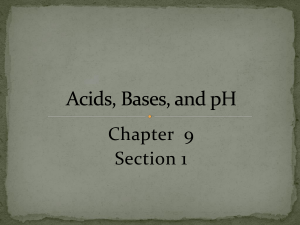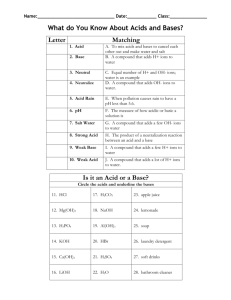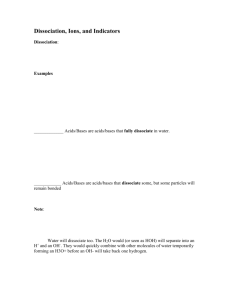Acids, Bases, and pH - Newington High School
advertisement

Chapter 9 Section 1 Explain the chemical composition of acids and bases, and explain the change of pH in neutralization reactions. I can differentiate between acids and bases. When dissolved in water, they ionize (form ions) Form H+ (Hydrogen) ions, which attach to water molecules to form hydronium ions, H3O+ Properties: Taste sour Blue litmus paper turns red Conduct electric current Corrosive Chemical Equation Reactants Products Complete ionization in water High concentration of hydronium ions in the liquid Strong acid Conducts electricity Strong electrolyte Weak acids Low concentration of hydronium ions in the liquid Do not conduct electricity well Weak electrolyte Double headed arrow Corrosive Can damage living tissues Vapors can be harmful to eyes, mouth and lungs Wear safety goggles, gloves, lab apron When dissolved in water form OH- (hydroxide ions) Properties Tastes bitter Solution feels slippery Turn red litmus paper blue Like acids, bases can also damage the skin When bases dissolve in water, they ionize. Na+ NaOH + OH- Not all bases contain OH Some will react with water to form hydroxide ion NH3 + H2O NH4+ + OH- High concentration of OH- in the solution Ba(OH)2 Ba2+ Complete ionization in water Good conductor of electricity Strong electrolyte + 2OH- Low concentration of OH- in solution NH3 + H2O NH4+ Do not ionize completely Not a good conductor of electricity Weak electrolyte + OH- Bases are corrosive and can damage living tissue Wear safety goggles, gloves and a lab apron!! What ions do acids produce? What ions do bases produce? What is the difference between a strong acid and a weak acid? What is the difference between a strong base and a weak base? Why should we observe lab safety rules when working with acids and bases? Learning Target Checkpoint How do you differentiate between acids and bases? I can explain pH. You can determine if a substance is an acid or a base by using an indicator. An indicator is a substance that changes color in the presence of an acid or base. Indicators measure the level of hydronium ions. The level determines if a substance is acidic or basic. Cabbage juice can be used as an indicator Litmus paper is a common indicator catalog.flatworldknowledge.com Acids turn blue litmus paper red Bases turn red litmus paper blue Only indicates if a substance is an acid or a base To determine strength or weakness, pH values are used profmarsolais.com A measure of the concentration of H3O+ ions in solution Acidity or basicity of a solution can be critical Enzymes in your body will not function properly if your blood is too basic or acidic Fish cannot survive in waters that are too acidic or basic hapnotes.wikidot.com ck12.org • Small differences in pH mean large differences in acidity • Example: pH of coke = 3 pH of coffee = 5 Coke is 102 , or 100, times more acidic than coffee. ch302.cm.utexas.edu gizmodo.com Lemon juice has a pH of 2.2. Is it an acid or a base? Detergents such as Tide have a pH of about 10. Is Tide an acid or a base? Seawater has a pH of 8.2. Is seawater an acid or a base? The inside of your mouth has a pH of 7. Is it an acid or a base? 409 cleaner contains ammonia that has a pH of 12. What will 409 do to red litmus paper? A soft drink has a pH of 3.2. What will it do to a piece of red litmus paper? You can find pH from the concentration of a strong acid. pH is the negative power of 10 that is used to describe the concentration of H3O+ ions. The concentration of H3O+ in pure water is 1 x 10-7. The pH of pure water = 7 The concentration of H3O+ ions in a solution of a strong acid is the same as the concentration of the acid. Determine the pH of a 0.0001 M (Molar) solution of the strong acid HCl. concentration of H3O+ ions = concentration of HCl concentration of H3O+ ions = 0.0001 M = 1 x 10-4 M pH = -(-4) = 4 What is pH? How do you determine the pH of a substance?







